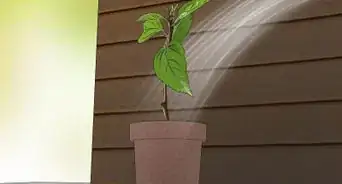wikiHow is a “wiki,” similar to Wikipedia, which means that many of our articles are co-written by multiple authors. To create this article, volunteer authors worked to edit and improve it over time.
This article has been viewed 45,149 times.
Learn more...
Heather (Calluna vulgaris), also known as Scotch heather and ling, are often used as groundcover plants and in borders or as background landscape plants. Heather can be rather difficult to grow well but they will thrive in colder climates and when grown properly and maintained, will display a thick mat of green or gray-green foliage. Though heather blooms profusely in the summer in hues of pink, purple, red and white, they will develop a purple or bronze blush in the fall and winter.
Steps
Part 1: Creating the Right Soil For Planting
-
1Plant heather in sandy loam soil that contains organic matter. These plants do not do well in slow-draining, clay soil, as wet conditions can lead to stem and root rot. Organic matter like sphagnum peat moss, well-aged cow manure, pine bark humus, leaf mold or compost will help heather grow properly and beautifully.
- If your heather has root rot, the stems will wilt as though they are drought-stressed and develop soft rotten spots. Heather plants are rarely salvageable when they develop rot and should be replaced with a new, healthy plant.
-
2Test the soil to make sure it has an acidic pH of 6.1 to 6.8. Heather grows best in soil with higher pH levels. They will develop chlorosis or very pale green leaves if they are grown in neutral to alkaline soil as they cannot absorb certain, necessary nutrients.
- Use a soil pH test kit to test the soil. The kit can be purchased at your local garden center.
- To determine the soil’s pH, dig 4 inches deep into the soil to get a good test sample. Avoid touching the soil as contact with your skin can change the soil pH. Let the soil sample dry before testing it. Pour the sample into a clean glass container, add distilled water and the chemicals that are in the test kit. Stir or shake the mixture vigorously and let it sit until the soil settles to the bottom. Compare the color of the liquid to the test strip to determine the soil pH.
Advertisement -
3Adjust the soil pH if it is at 6.0 or lower or above 6.8. You can do this by mixing in lime, iron sulfate, or organic matter into the soil.
- Sandy soil will require about 1 ¼ pounds of lime per 25 square feet to bring the pH up from 5.5 to 6.5 or about 1/3 pound of iron sulfate to adjust the pH down from 7.5 to 6.5. Mix the lime or iron sulfate into the top 6 inches of soil thoroughly before planting the heather. If the heather has already been planted, gently work the lime or iron sulfate into the top 1 inch of soil, being careful not to disturb the plant’s roots.
- Before planting the heather, a 3- to 6-inch layer of sphagnum peat moss, well-aged cow manure, pine bark humus, leaf mold or compost should be mixed into the top 8 to 10 inches of soil thoroughly with a tiller. If the heather has already been planted, spread a depth of 2-inches of organic matter around the plant and mix it into the top inch of soil. Spread a 1-inch depth of sphagnum peat moss over the soil around the heather to help keep the area moist.
Part 2: Maintaining Your Heather Plant
-
1Use a thin metal rod to determine the depth of the wet soil. To avoid under watering or overwatering the heather, check the soil often with a thin metal rod.
- Push the rod into the soil until it meets some resistance. Grasp the rod just above the soil when it hits dry dirt, pull the rod out and measure the depth of the wet soil.
-
2Give the heather two inches of water every week. You may need to water the plant more in hot weather or a hot climate. When heather is not being watered enough, it will wilt and turn yellow so check the soil often to make sure it doesn’t dry out.
- Pour enough water over the soil around the heather to moisten it to a depth of 6 inches. You can measure the depth with the thin metal rod.
-
3Don’t worry about fertilizing your heather plant. Heather rarely needs fertilizer, especially if organic matter like well-aged cow manure and compost are mixed into the soil. In fact, too much fertilizer will kill heather plants.
-
4Prune the heather in the fall after it finishes flowering. Trim off the faded flowers with sharp hand pruners or hedge shears. Snip off the tips of the taller stems to tidy up and better shape the heather.
- Be sure to rake up all of the trimmings and remove them from the garden to reduce the possibility for fungal or bacterial disease like stem or root rot.
Community Q&A
-
QuestionDoes this plant, now potted, need a lot of sun or shade?
 NinoxTop AnswererThe plant can grow in shade, but prefers direct sunlight. Note that pale foliage cultivars prefer half shade.
NinoxTop AnswererThe plant can grow in shade, but prefers direct sunlight. Note that pale foliage cultivars prefer half shade. -
QuestionWhat if all the flowers are faded?
 NinoxTop AnswererHeather plant flowers don't usually last long. They will fade and dry with the sun.
NinoxTop AnswererHeather plant flowers don't usually last long. They will fade and dry with the sun. -
QuestionDo the flowers stay year-round indoors?
 Community AnswerMost plant nurseries use a water soluble plant food mix in their water about twice a week. This keeps a plant from going into its dormant stage and continues to produce flowers.
Community AnswerMost plant nurseries use a water soluble plant food mix in their water about twice a week. This keeps a plant from going into its dormant stage and continues to produce flowers.
Things You'll Need
- A soil pH test
- Lime or iron sulfate
- Organic matter like sphagnum peat moss, well-aged cow manure, pine bark humus, leaf mold or compost
- A thin metal rod
- Hand pruners or hedge shears
































































